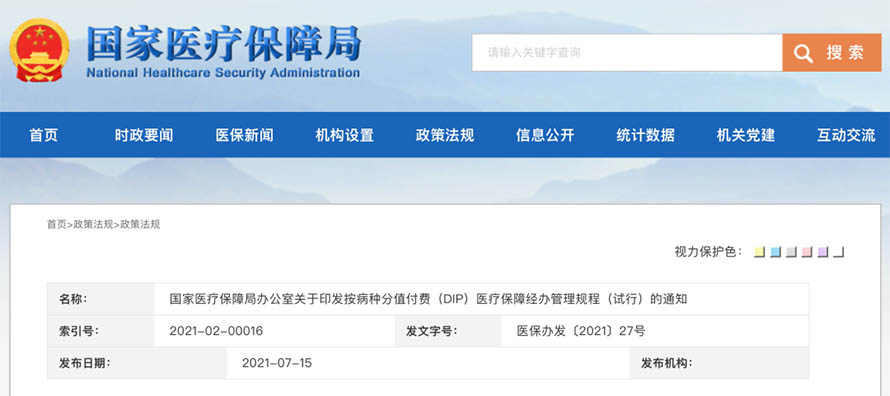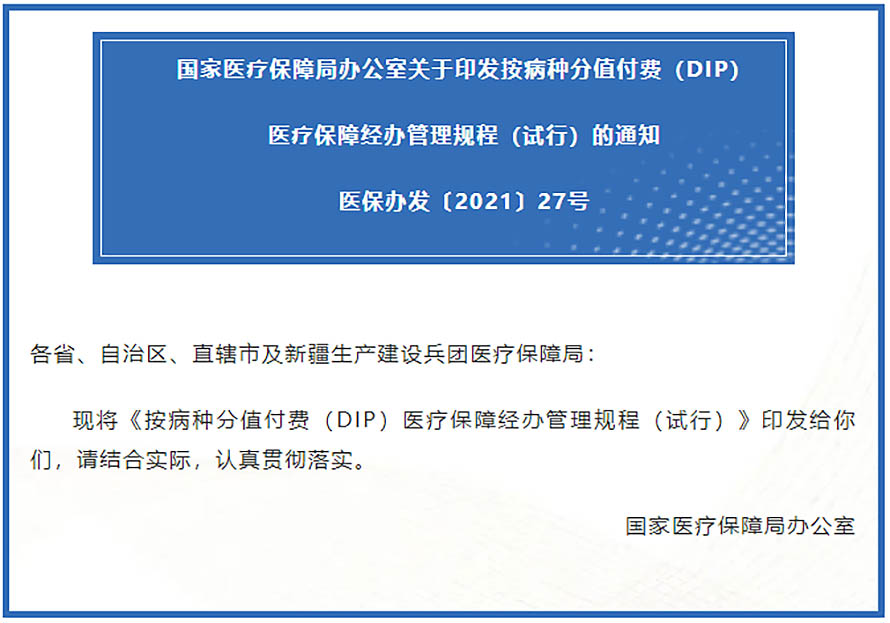

In order to implement the "Opinions of the Central Committee of the Communist Party of China and the State Council on Deepening the Reform of the Medical Security System", deepen the reform of medical insurance payment methods, improve the efficiency of the use of medical security funds, actively and steadily promote the total budget of the regional point method and the payment according to the value of the disease, and standardize the classification This regulation is formulated for the management of DIP.
Chapter 1 General Provisions
The first DIP is an important part of deepening the reform of medical insurance payment methods, and is an original payment method in line with China's national conditions. Supported by big data, DIP combines the point method with the total regional budget to guide the rational allocation of medical and health resources, reflect the value of medical staff's labor services, ensure the basic medical needs of insured persons, and promote the smooth and efficient operation of the medical insurance fund.
Article 2 The medical security handling agency (hereinafter referred to as the handling agency) shall actively promote DIP handling management services in accordance with the requirements of the national medical security policy, do a good job in agreement management, carry out data collection and information construction, and establish regional total budget management. Develop indicators such as scores, carry out audit and settlement, assessment and evaluation, audit and inspection, and do a good job of handling and management work such as negotiation and dispute handling. At the same time, establish incentive and restraint and risk-sharing mechanisms to encourage designated medical institutions to establish and improve internal management mechanisms that are compatible with DIP, reasonably control medical expenses, improve medical service quality, and orderly promote settlement with designated medical institutions based on disease points.
Article 3 Provincial-level agencies shall effectively implement the guidance and organizational responsibilities, guide the overall planning area to formulate DIP handling management procedures suitable for the overall planning area, solidly promote the implementation of the regulations, and monitor and evaluate the operation of the agency. Provincial-level agencies shall formulate the province-wide DIP payment management regulations based on these regulations.
Article 4 The main content of DIP business includes:
(1) Improve the management of agreements, establish and improve the negotiation and negotiation mechanism between medical insurance agencies and designated medical institutions;
(2) Strengthen data governance in accordance with nationally unified business and technical standards to provide support for the development of DIP business;
(3) Implement regional total budget management and reasonably formulate the total DIP payment budget;
(4) Determine the scores of disease types and the grade coefficients of medical institutions in the overall planning area;
(5) Carry out review and monthly pre-settlement, or monthly settlement;
(6) Carry out annual liquidation and calculate the amount paid by the DIP annual liquidation medical insurance fund of each designated medical institution;
(7) Strengthen the monitoring of the entire DIP process and strengthen the assessment and evaluation.
Article 5 DIP is mainly applicable to the settlement of inpatient medical expenses (including day surgery, etc.) in the overall planning of regional medical insurance.
Chapter II Agreement Management
Article 6 DIP is included in protocol management. The handling agency and the designated medical institution have signed a medical security service agreement to clarify the rights and obligations of both parties. The DIP medical service agreement can be signed separately, or on the basis of the existing medical service agreement, clauses related to DIP management can be added.
Article 7 The contents of the agreement include DIP data submission, fee review, declaration and settlement, fee appropriation and dispute settlement. According to the needs of DIP management, improve the protocol management process, standardize the DIP management procedures, and strengthen the contract performance responsibilities of designated medical institutions.
Article 8 According to the "Regulations on the Supervision and Administration of the Use of the Medical Security Fund" (State Order No. 735) and the "Interim Measures for the Administration of Medical Security Designated by Medical Institutions" (National Medical Security Administration Order No. 2), designated medical institutions shall be paid in DIP Focus on violations such as high set of scores, inconsistencies in diagnosis and operation, etc., and specific solutions are proposed.
Chapter III Information System Construction and Data Collection
Article 9 The coordination area shall accelerate the implementation and application of the unified national medical insurance information platform, strengthen data governance, provide support for DIP business, and realize the data collection and quality management of DIP business, DIP disease grouping and value assignment, and designated medical institutions The calculation and generation of grade coefficients, data processing and score calculation of designated medical institutions, audit and settlement management, monitoring and early warning functions.
Article 10 The overall planning area shall guide designated medical institutions to establish hospital information systems and upgrade the information systems according to the needs of DIP business, and do a good job in the data interface of the medical insurance information system.
Article 11 Strengthen the guidance, training and data quality management of data uploaded by designated medical institutions, and review from the aspects of timeliness, completeness, rationality, and standardization, and timely feedback to designated medical institutions for verification and re-collection of problem data. Upload.
Article 12: Medical institutions with clearly determined points shall strictly follow the medical security fund settlement checklist and fill-in specifications to fill in the diagnosis and treatment information and cost information for hospitalization services, and upload them to the medical insurance information system in a timely and accurate manner as required. The medical insurance settlement checklist should accurately reflect the diagnosis and treatment information during hospitalization and the details of medical charges, and the disease diagnosis code used should be the unified version of the national medical insurance.
Chapter IV Budget Management
Article 13 The overall planning area shall follow the basic principles of "fixed income and expenditure, balance income and expenditure, and have a slight balance", on the premise of guaranteeing the basic medical needs of the insured, comprehensively consider the medical development, and reasonably determine the regional annual hospital medical insurance fund budget Total expenditure.
Article 14 The preparation of the fund budget based on the actual expenditures of the fund in the previous years requires comprehensive consideration of the following factors:
(1) Fund income of the current year;
(2) Changes in the insured population;
(3) Adjustments to medical insurance policies such as treatment standards;
(4) Medical and health development in compliance with the regional health plan;
(5) Changes in medical needs and price levels of the insured persons;
(6) Major public health incidents, natural disasters and other circumstances affecting expenditures;
(7) Other factors.
Article 15 The adjustment fund (hereinafter referred to as the regional adjustment fund) is mainly used for the reasonable over-expenditure sharing in the annual liquidation according to the actual establishment of the overall planning area of the annual disease-based adjustment fund (hereinafter referred to as the regional adjustment fund).
Article 16 Based on the budget expenditure of the annual hospital medical insurance fund, deduct the regional adjustment fund, the cost of medical treatment in other places, and the expenses not included in the DIP settlement, and determine the annual DIP medical insurance fund expenditure.
Article 17 During the year, due to special circumstances such as relevant major policy adjustments, major public health incidents, natural disasters, etc., it is necessary to adjust the DIP medical insurance fund budget expenditures or regional adjustment funds, the overall planning area shall adjust according to the actual situation.
Chapter V Determining the Score of Disease Types
Article 18 Establish a local disease catalogue database. Based on the results of national pre-grouping, the overall planning area determines the disease types and disease scores, etc., and forms a local DIP directory database. If the actual number of cases is small and the results of the evaluation of the disease category score are unstable, it is necessary to make a record and analysis of the disease category. If it is really necessary to add some disease types, the catalog database can be expanded, marked and reported to the National Medical Security Bureau for the record.
Article 19 Calculate the score and point value of the disease category. Calculate the score of each disease based on the average medical expenses of hospitalization in the area or the average medical expenses of the standard diseases. The benchmark disease is usually a disease that is widely developed locally, has a clear clinical path, few complications and comorbidities, mature diagnosis and treatment technology, and relatively stable cost. Under the total budget, the point value is calculated based on the annual medical insurance expenditure, the medical insurance payment ratio and the total score of the cases of each designated medical institution.
Article 20 Establish an auxiliary catalog score adjustment mechanism. On the basis of the main catalog, the detailed classification of diseases based on factors such as age, comorbidities, complications, etc., determines the adjustment coefficients of each auxiliary classification, and adjusts and corrects them on the basis of the scores of the diseases.
Article 21 Establish a calibration mechanism for deviation cases. Calibrate the scores of diseases that are seriously deviated from the actual medical expenses to make them consistent with reality. If the total medical cost of a case differs from the total medical cost of the designated medical institution at the same level in the previous year by a certain percentage, it is regarded as a deviation case and the score needs to be recalculated.
Article 22 Establish a special case review mechanism. For special cases such as the number of hospitalization days that are significantly higher than the average, the cost deviation is large, the length of ICU hospitalization days, or the use of new medical technology, designated medical institutions can apply for settlement according to special cases, and assign points after accumulating a certain number of cases . The medical insurance fund can be paid after negotiation and negotiation.
Article 23 Establish a dynamic adjustment mechanism for the grade coefficient of designated medical institutions. Comprehensively consider the level, functional positioning, medical level, specialty characteristics, disease structure, medical insurance management level, agreement fulfillment and other relevant factors of designated medical institutions, set the level coefficient of designated medical institutions, and distinguish the designated medical institutions of different levels and different management service levels. The scores of medical institutions are adjusted dynamically.
Chapter VI Review and Settlement
Article 24 Instruct designated medical institutions to carry out monthly declaration and settlement work in accordance with regulations.
Article 25 Strengthen the intelligent review of medical insurance, and use big data methods such as balanced index to carry out operational monitoring. Focus on reviewing situations such as high sets of scores and discrepancies between diagnosis and operation. If abnormal situations are found, they will be dealt with accordingly.
Article 26 Pre-appropriation of funds. Coordinating areas can prepay part of the medical insurance funds to designated medical institutions in accordance with national regulations to ease the pressure on their capital operations. In emergencies such as an outbreak of an epidemic, special funds can be allocated in advance in accordance with national regulations.
Article 27 Establish a medical insurance quality guarantee fund. The monthly settlement fees declared by designated medical institutions can be deducted according to a certain percentage and used as a guarantee for the quality of medical insurance services of the year. The amount of quality guarantee is linked to the annual comprehensive assessment and other conditions.
Article 28 Carry out monthly pre-settlement. The monthly settlement fees declared by designated medical institutions can be pre-settled on a monthly basis according to a certain proportion, and the part that has not been allocated will be included in the annual settlement process. It can also be settled monthly according to the actual locality.
Article 29 Regions where conditions permit can conduct regular case reviews, and organize experts to conduct random inspections of the deviation cases and special cases of the implementation of DIP on a proportional basis. The results of the case review are linked to the annual liquidation.
Article 30 Carry out annual liquidation. According to fund income, DIP medical insurance fund expenditure, combined with agreement management, assessment, monitoring and evaluation and other factors, carry out annual liquidation, mainly including the following:
(1) Calculate the annual score and point value of the overall planning area;
(2) Determine the total amount of pre-liquidation of each designated medical institution according to the point value and the annual score of each designated medical institution;
(3) Comprehensively consider factors such as the medical insurance fund payment amount of the designated medical institution after review and deduction, the DIP annual pre-clearing payment amount, the agreement management situation, the regional adjustment fund and other factors, calculate the balance retention or excess compensation amount, and determine the designated medical institution Annual medical insurance fund payment amount;
(4) Check the difference between the DIP annual medical insurance fund payment amount of each designated medical institution and the monthly prepayment amount, and allocate the medical insurance fund to the designated medical institution.
Chapter VII Audit and Inspection
Article 31 The entire process of DIP shall be monitored before, during and after the event, relying on information technology to carry out daily audits, mobilize online and offline resources, promote the linkage of cost audits and audit inspections, and improve management efficiency.
Article 32 Make full use of big data analysis and other technical means to monitor and analyze medical service-related behaviors and expenses, focusing on monitoring the quality of settlement lists and daily diagnosis and treatment behaviors, the reasonableness of payment standards, and the hospitalization behavior of insured persons. Aiming at different links, objects, settlement methods, types of medical treatment, etc., gradually establish and improve an intelligent monitoring rule library covering the full caliber and the entire process of medical insurance payment.
Article 33 The audit methods for designated medical institutions include daily audits and special audits. Daily audits mainly conduct audits and verify the standardization of disease declarations based on the doubtful issues found in data monitoring, focusing on the investigation and handling of violations such as high set scores, diagnosis and operation inconsistencies; for multiple or major violation clues, medical treatment, medical records and other fields can be organized Experts carry out special audits.
Article 34 Social supervision. Unblock the channels for complaints and reports, give play to the role of public opinion supervision, encourage and support all sectors of the society to participate in supervision, and realize a benign interaction of multi-party supervision.
Chapter 8 Assessment and Evaluation
Article 35. The assessment of the annual implementation of agreements and implementation of medical insurance policies by designated medical institutions shall be conducted to provide a basis for determining the amount of DIP annual pre-liquidation payments and annual liquidation.
Article 36 The establishment of DIP special assessment and evaluation can be included in the assessment of the agreement of designated medical institutions. The method of combining daily assessment and on-site assessment shall be adopted. The assessment indicators of the agreement shall include relevant indicators of DIP operation.
Article 37 The evaluation indicators should be combined with the performance evaluation of designated medical institutions to determine the evaluation methods, scoring subjects, and scoring standards of each indicator to ensure the objectivity and operability of the indicator evaluation. Apply the assessment results of designated medical institutions to the DIP annual pre-clearing of designated medical institutions.
Article 38. Carry out DIP operation monitoring, periodically evaluate the effectiveness of DIP operation, and conduct comprehensive evaluations from different dimensions such as medical expenses, medical resource utilization efficiency, medical behavior changes, medical quality level, and insured patient satisfaction. Reflect the effect of DIP operation.
Chapter IX Negotiation and Dispute Settlement
Article 39. A collective negotiation and negotiation mechanism should be established with designated medical institutions, promote collective negotiation of designated medical institutions, organize experts or entrust third-party institutions to carry out disease catalogues, dynamic adjustment of scores, etc., and promote the formation of joint construction, joint treatment and sharing. New pattern of medical insurance governance.
Article 40 Negotiations and negotiations must fully consider the interests and development of various designated medical institutions. All levels and types of designated medical institutions can send representatives to participate in the negotiation and negotiation.
Article 41 Strengthen organization and management, and establish working mechanisms related to consultation and negotiation. Put forward a consultation plan, accept inquiries from designated medical institutions, and reach a unified opinion through full discussion and consultation.
Article 42: Establish a DIP dispute settlement mechanism to resolve disputes raised by designated medical institutions in accordance with the principles of "fairness, fairness, objectiveness and reasonableness, multi-party participation, and timely processing".
Article 43 All kinds of disputes arising from DIP payment between handling agencies and designated medical institutions shall be resolved in accordance with relevant laws and regulations and medical security service agreements.
Chapter 10 Supplementary Provisions
Article 44 The National Medical Security Administration is responsible for the interpretation of these regulations.
Post time: Aug-03-2021
